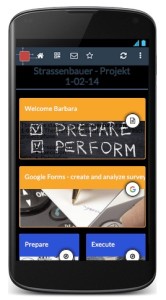Piloting with AchSo and getting feedback on Learning Toolbox – Part Three: Introducing Augmented Reality to construction vehicle drivers
In my two latest blogs on the EU-funded Learning Layers (LL) project I started a series of reports on a field visits in the construction sector – and in particular in the training centre Bau-ABC. Our visitors from Aalto University (Finland) have introduced their tools and our colleagues from the University of Innsbruck (UIBK) gathered feedback on our pilot with the Learning Toolbox (LTB). In my first post I reported on the introduction of video annotation tool AchSo. In my second post I reported on the feedback that apprentices have given after using the LTB. In this third post I will report on the introduction of Social Augmented Reality (SoAR) – also a tool developed by the colleagues in Aalto University.
The idea of Social Augmented Reality (SoAR)
For lay people (like myself) the most likely encounters with Augmented Reality have been the commercial applications that have provided some kind of pop-up information windows or visuals that enrich web-based information. In such applications there is a basic layer of information that is complemented with an additional one – to the benefit of the consumer-viewer. As a contrast, the idea of the Social Augmented Reality (SoAR) is to provided enriched communication with all channels of mobile devices: speech, video and tagging (drawing). When using SoAR in mobile phone calls, the counterparts can see each other and talk to each other (like using Skype), they can switch the screens that they are viewing and they can tag live videos by drawings. Whilst this idea had been presented in some consortium meetings of the LL project, we had first put the emphasis on introducing the integrative toolset Learning Toolbox (in March) and then the video annotation tool AchSo (on the two first days of this field visit). On the third day of the field visit we had the chance to introduce SoAR to a group of apprentices specialising as construction vehicle drivers (Baugeräteführer).
The introduction of SoAR in Bau-ABC
Since the visitors from Aalto and UIBK had spent the second day of visit introducing the AchSo video annotation tool for a group of construction vehicle drivers (Baugeräteführer), the step to introducing AchSo (see my first blog of this series) was a smooth transition from one tool to another. Sanna Reponen presented the functionality of the tool at the outdoor training areas and the testing started immediately. Normally, the driving and operating of construction site vehicles (caterpillars with different additional features) is organised in groups – one is the driver, two others are supporting the lifting and adjusting operations while others are waiting for their turns. The supervising trainer is not all the time present – since the training is based on the culture of self-organised learning (apprentices are expected to grow into independent task preparation, planning and implementation).
Now, in the beginning, the trainer got a mobile phone in which SoAR was uploaded and one of the apprentices got another one. In this way the trainer was able to rotate between different training areas and his office without losing contact with this group of trainees. During one of the first test calls there was a real problem case, when the cylinders of the caterpillar started making unusual noises – just when the trainer was out of sight. Thanks to the use of SoAR the apprentices could show him the case and from the noise he could conclude, where the problem might be. And he could give in real time advice, what measures to take to solve the problem (or at least to avoid any damage). After this ‘real’ case, several other apprentices made similar test calls and the trainer responded from different locations. Altogether, the communication worked well but the background noise from the engines of the vehicles was a major disturbance. (However, the trainers have already tested earmuffs that can filter the background noise and these can be used with SoAR as well.)
At the end of the day we had a feedback session with the apprentices. They gave very positive feedback on the test situation and were looking forward to further development of the tool. In a similar way the trainer had made a very positive experience with his testing. Altogether, we concluded that SoAR is a very positive add-on to the Learning Layers tools.
– – –
I think that this is enough of this field visit. We made immediate arrangements to push forward the work with Learning Toolbox in some further trades and in the area of health and safety (Arbeitssicherheit und Gesundheitsschutz). We also made preliminary arrangements for a similar field visit (for introduction of AchSo and SoAR combined with further evaluative measures). So, there is more work to be done before and after the summer break.
More blogs to come …


